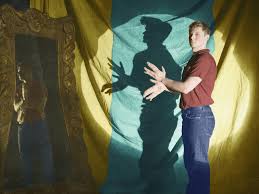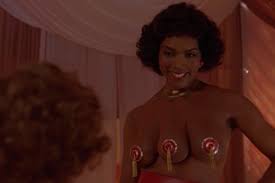In
The Travels of Sir John Mandeville, the narrator tells of some mysterious races and monsters he observes during his journey. Many of the races and monsters he meets can be related to the characters on the television show
American Horror Story: Freak Show.

To begin, Sir John Mandeville tells of the land of the Amazons, which is solely inhabited by women. He describes the Amazons as "...noble and wise warriors...." who are respected by men (neighboring kings) and who are valuable warriors. In
American Horror Story: Freak Show, there is a character by the name of Amazon Eve, who is also somewhat of a noble warrior on the show. Much like the Amazons described by Mandeville, Amazon Eve is respected by her comrades; even though she is a woman, she offers protection and aids in fickle situations. She also offers motherly affection to some of her fellow freaks, which is similar to the Amazons- even though they possessed manly qualities, they still raised children (female ones, anyway).

"There are many different kinds of people in these isles. In one, there is a race of great stature, like giants, foul and horrible to look at; they have one eye only, in the middle of their foreheads. They eat raw flesh and raw fish..." This quote from Mandeville begins his descriptions of the "monsters" he comes in contact with throughout his travels. The description given depicts similar aspects of the character Meep in
American Horror Story: Freak Show. For instance, Meep is known on the show for biting off animal heads, which coincides with Mandeville saying the monsters he saw "eat raw flesh and raw fish." Furthermore, his grotesque teeth and slightly abnormal physical features made him "foul and horrible to look at."

"In another there are people of small stature, like dwarfs, a little bigger than pygmies..." Ma Petite in
American Horror Story: Freak Show is a tiny dwarf woman. The tiny people Mandeville described seemed a little more terrifying, for he says they hissed and had a hole for a mouth. Ma Petite's character is actually very charming and sweet, but she is viewed as abject because of her small size.

"In another isle there are people whose ears are so big that they hang down to their feet like four-footed beasts..." Although there are no characters with huge ears in
American Horror Story: Freak Show, there are characters who have excessive body parts. Jimmy (depicted top right) is known as Lobster Boy, for his fingers are fused together, giving them the appearance of lobster claws.

The picture to the left shows Bette and Dot. They are considered freaks because they are Siamese sisters who share a body, or rather their body has two heads.
Paul, who is shown in the bottom picture at the right, has deformed arms and fingers that resemble flippers, or webbed feet.

"There is another isle where the people are hermaphrodite,
having the parts of each sex, and each has a breast on one side..." When this character is first met, Desiree claims to be a hermaphrodite. Desiree does not have a single breast on each side like the hermaphrodites Mandeville described, but she does in fact have an extra breast. So, not only is she abject because she is considered both male and female (until she found out that her "penis" was just an abnormal looking clitoris), but her extra breast makes her sexually excessive.
Many more characters in
American Horror Story: Freak Show can also be related to characters in
The Travels of Sir John Mandeville. The comparisons and resemblances between the two exemplify that qualities viewed as abject in the Middle Ages are still viewed as abject today. Abnormalities, mostly in appearance, are considered fascinating, horrifying, and entertaining, which is why characters such as dwarf people or Amazons were the topics in literature back then and are still the topics in popular culture today.
Alexia, your connections between American Horror Story characters in the current season and their medieval counterparts are accurate. In both scenarios, the humans with deformities on the television show and the creatures in medieval literature are “othered” because of their differences. This is even more the case in the television show, because the creatures in American Horror Story are human in nature and therefore always a representation of how they differ from what society considers to be “normal”. Similar to how we have studied the way in which non-Christians are represented in medieval literature by monstrous races or evil Jews, the humans in American Horror Story function as a metaphor for oppressed races throughout history.
ReplyDeleteI really dig the comparisons you have drawn between the craziness that is Sir John Mandeville's travelogue and Freak Show. I had not realized how many of these medieval "monstrous races" had carried over into the show. What's more is how in the show they were made even more human than in the medieval texts. It's not surprising since the world we live in today is so much more varied and lines of race and culture are crossed. Still speaks to the fear of what is strange that seems to be inherent to us humans. I loved Freak Show for the way it pushed on the limits of normal and monstrous and for how it brought you to see humanity in different forms. I wonder how the world now versus in the middle ages responds to these portrayals.
ReplyDeleteI, too, thought your comparison of the two seemingly very different forms of entertainment, were not only accurate but very interesting. As time goes by, it is clear that much of what we consume of either television or literature is merely a newer, brighter, sometimes more glamorous or more obscene version of story's that have already been told. Although Freak Show pushes the boundaries and the extremes of what we view today as the "outsiders" of the human population due to physical abnormalities, it does humanize them to a certain extent. In contrast, The Travels of Sir John Mandeville, depicts monsters only to further humanize the British, by creating a connection between everything foreign or unfamiliar with the disgusting and inhumane.
ReplyDeleteThis is a really great comparison. Throughout American history, the traveling show or the circus provided a shared cultural connection between really rural areas. Circuses could spread news and entertainment and provided kind of a festival or celebration time where work would be suspended and rules relaxed. While circuses could be benign, they also included cruelty in their acts, including animal abuse and exploiting the disabled and the different in the "freak shows," like in American Horror Story. However, it's important to note that circuses existed to entertain people, and their existence depended on giving people what they wanted. An exhibit that didn't attract attention or was met by disgust would be canned immediately. So the enduring cultural tradition of the freak show must have filled some societal need. it might be that the temporary presence of the freak show reinforced the identity of the town as a community, just like the presence of monsters and Saracens reinforced Christian community. This is an excellent comparison.
ReplyDelete